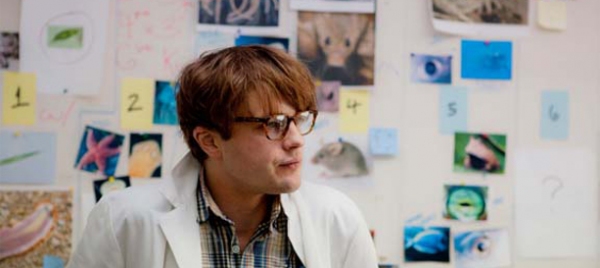
Mike Cahill’s I Origins, which won this year’s Alfred P. Sloan Feature Film Prize at the Sundance Film Festival, opens with a series of extreme close-ups of human eyes. Beautiful, mesmerizing and each utterly distinct, these close-ups make the familiar organ feel like a mystical mix of organic material and precious gemstone. Could such a complex and magical object simply be a result of Darwinian natural selection? Yes, according to the film’s protagonist, Ian Gray, a white-coated molecular biologist (played by Michael Pitt), whose life’s work is bent on showing how the “irreducible complexity” of the human eye can be accounted for by evolution.
But while Gray’s journeys into science, love, fate and mysticism in Cahill’s film are fraught with conflict, the actual research on the evolution of the eye turns out to be far less mysterious. Jonathan A. King, a professor of molecular biology at MIT and a lecturer at the 2009 Evolution of the Vertebrate Eye Symposium, spoke to Science and Film about some of the issues raised by I Origins, and whether the eye is, in fact, “a window onto the soul.”
Sloan Science and Film: Where does your interest in the eye stem from?
Jonathan King: I am a protein bio-chemist. I study the folding of proteins and the misfolding and aggregation of proteins in many of the chronic diseases that ravage the population. In Alzheimer’s or Parkinson’s, what happens is that proteins, instead of folding up and keeping to their compact conformation, unfold and stick together and form these large aggregates. At some point, I was myself moving on, into my early 70s, and thought I ought to turn my research to these pathologies, which are, on the one hand, found in the aging population, and on the other hand, involve protein unfolding, which my lab knows how to study. One of the prevalent protein disposition diseases in humans is cataracts. It’s the major cause of blindness in the world. It’s a very serious public health burden. We thought if we could understand how these proteins aggregate and stick together in the lens of the eye, maybe we can come up with a preventive therapy, like an eye drop, that slows down the development of a cataract. And once you start studying an eye disease, you have to become knowledgeable about the eye. I was a biologist by training with a Ph.D. in genetics. I’ve always been interested, as many biologists are, in evolution and I was impressed by Darwin’s contributions. So it all came together.

SSF: I Origins brings up the debate about whether theories of evolution can accommodate for the “irreducible complexity” of the eye. What is the current scientific thinking on this?
JK: Among biologists, this question has faded away as we’ve come to understand the extraordinary capacity of natural selection over time, over hundreds of millions of years to invent and develop new proteins, new organelles, new organs. And we've now learned more about the eye’s origins. For example, Cahill’s film apparently describes the Pax-6 gene, which is a control circuit we now know is found broadly in many, many different organisms that are involved in turning on the genes that you need for vision.
I study the crystallins of the eye lens, which are essential for the transparency of the lens, permitting light to pass through and reach the retina. It turns out you can find ancestors of this protein in sea squirts. But sea squirts don’t have eyes; they have an eye spot. And it may be that the origin of this protein has to do with the fact that it’s resistant to ultraviolet light; because if you’re going to be transparent, you’re going to be constantly bathed in ultraviolet light, which damages proteins. So we think that the eye lens proteins evolved before there was an eye to have stability and resistance from damage to ultraviolet light.
This trait was then recruited at the point when vertebrates were evolving and there was selection for acute vision to catch prey, so having a lens that could focus light was very useful. The proteins were already there; it’s just some of the parts pre-evolved for different reasons. That happens all the time in biology, where something has evolved under selective pressure and then a new stress emerges and, low and behold, it turns out you have the right part for reasons that you couldn’t have predicted beforehand.
And then there are advances in genomics where you can see the ancestral genes for many other proteins that are found in the eye. Some of the complexity is in the wiring from the retina to the brain. But brains, or concentrations of neural tissue, are found in very very primitive animals like flat worms, so you can see as the organism gets more advanced, the complexity of the wiring gets more and more complicated and you have more capacity for more and more connections from the retina. It doesn’t mean you can actually see the path to the wiring from a primary retina, but it doesn’t seem that surprising.
The Harvard paleontologist, Farish Jenkins, Jr., who died recently, discovered the first walking fish. When they actually found the fossil, even a lay person could see that there was something different about its bone structure. For example, the neck had evolved, so the animal moved its neck in a way that a fish doesn’t have to do, but if you’re on land, you have to. And all of a sudden, the hypothesis that these fish gave rise to the first terrestrial four-legged animals becomes much more concrete, because you can see these intermediate stages. But with the vertebrate eye, it’s soft tissue. So we don’t have bones preserved that you do in the joints. It’s a slower, longer process to see what were the actual steps in the evolution of a high resolution vertebrate eye.

SSF: In the film, the molecular biologists conduct an experiment where they create a worm that evolves a primitive kind of eye. Is this feasible?
JK: The early steps in the formation of the eye, which is the pinching off from the ectoderm, the outer layer of cells, to have something called an eye placode, or a ball of cells, sets the stage for the morphology of the eye. I can easily imagine if you activated the right genes you could move in that direction.
SSF: The script of I Origins features discussion of the “eye being a window to the soul.” I realize this is a cliché and it’s not scientific, but I wonder if this idea has any resonance for you?
JK: What does have resonance is that I used to work in professional development for science teachers and if you look at a high school class, and you get to the point where they’re discussing the senses, there’s no doubt that among a broad range of young people, the eyes and vision are what engages them. Everyone is more aware of the importance of vision than, say, touch or smell. They’re much more interested in eyes than ears. I believe that it comes from the fact that in human facial recognition and the relationships between individuals, the eyes play a much larger role—recognition, affection, who’s a friend, who’s a stranger. That’s not the same as the eye being the window into the soul. But eyes are a dominant feature of the human face. And humans are predominantly social. They don’t recognize each other by looking at the ears or the knees. They recognize each other by looking at the face.
RELATED
TOPICS